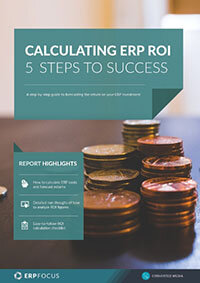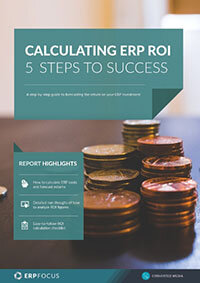5 Costs You Need to Accurately Forecast for ERP ROI
The costs of an ERP project are extremely important. After all, ERP ROI costs appear twice in the formula and returns only appear once, so accuracy is paramount. Some costs are pretty obvious and easy to calculate, while others will take considerable effort to estimate. Many of these costs require a broad range of business perspectives to estimate accurately.
Initial Costs
The initial cost of the software might seem like an easy one – just look at the vendor’s quote. But first, you must be sure all the optional modules you need are included. Remember that “you” includes the whole enterprise. A module or option that finance doesn’t even recognize might be the entire system to the quality department. If you are planning a phased-in approach, document all the costs and the time at which each is expected to arise. You might want to look at ROI with all costs included or only the initial costs but you must match your returns to the costs no matter the time frame.
SaaS Subscription
If you plan on using your ERP system on an SaaS basis, you still need to include the license fees in your ERP ROI costs. Add up the monthly cost over the time you plan to use the ERP to calculate this element.
Consultancy Costs
You will certainly need some help from consultants during your ERP project. Even an implementation planned over time with almost all internal resources needs some external guidance. Consultancy is always in danger of scope creep, so in order to calculate costs, you will need to clearly define the timeframe and extent of consultancy activities prior to the project.
Maintenance Costs
Maintenance costs must be included. These will include future upgrades to the ERP as well as the support agreement. For a simple ROI, total the maintenance costs over the expected life of this ERP or look forward at least seven years.
Recommended Reading: ERP Implementation - 11 Steps to Success
You will likely need to expand hardware and network systems to get the most value from the ERP system. Be sure your servers meet at least the minimum specifications from the ERP vendor. Better yet, aim to meet the optimal specifications or plan to include the cost of users waiting for their transactions to “save”. Those few seconds for each transaction adds up over time. Look into the future too. Your ERP will outlast most hardware so add in some replacement and maintenance costs on your hardware and network.
User Costs
Your users also incur costs during an ERP project. You plan to train them, don’t you? Training takes time. Will you bring in temporary help to make up for this training time or offer overtime pay? Just because some users are salary and not hourly, there can still be a cost if you provide comp time. Whether the policy of formal or informal those individuals will want their compensation.
Another user cost to be factored into your ROI is the time taken to become competent on the new ERP. On the first day, they will not do their jobs as fast as they do today. Some users will be up to speed in a few days and others will take weeks. Task frequency and length should be factored into these costs. The monthly closing process in finance is one example. An annual marketing campaign is another. Your costs should allow some efficiency reductions during the first few runs of each ERP process.
This is by no means a comprehensive list of ERP ROI costs, but it gives you a sense of the context and detail required to accurately calculate or predict costs. It is not as simple as looking at the price tag.
Free white paper

Calculating ERP ROI: 5 steps to success
Calculate your new ERP's financial benefits with this comprehensive guide

Featured white papers
Related articles
-

28 cost elements to include in your ERP TCO calculation
With differing definitions and more hidden costs than you can shake a stick at, ERP TCO can be a ...
-

CMMC Compliance: What Aerospace and Defense Manufacturers Need to Know
Key insights on CMMC compliance, deadlines, and securing DoD contracts with CMMC 2.0 certificatio...
-
![Three direct links between ERP and manufacturing revenue [image by Snowing on Freepik] Three direct links between ERP and manufacturing revenue [image by Snowing on Freepik]](/pictures/W1siZiIsIjIwMjUvMDEvMjAva2ZwYjAzb3gzX1RocmVlX2RpcmVjdF9saW5rc19iZXR3ZWVuX0VSUF9hbmRfbWFudWZhY3R1cmluZ19yZXZlbnVlX2ltYWdlX2J5X1Nub3dpbmdfb25fRnJlZXBpa18uanBnIl0sWyJwIiwidGh1bWIiLCI0MDB4MjY2IyJdLFsicCIsImVuY29kZSIsImpwZyIsIi1xdWFsaXR5IDg1Il1d/Three%20direct%20links%20between%20ERP%20and%20manufacturing%20revenue%20%5Bimage%20by%20Snowing%20on%20Freepik%5D.jpg?sha=b45b02a140cc8680)
Three direct links between ERP and manufacturing revenue
What you need to know to help you achieve a return on your manufacturing ERP investment


